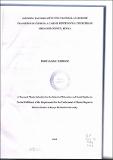| dc.description.abstract | Due to lack of defined transition structures transition period in many of the pentecostal churches becomes a period which produces considerable anxiety, confusion, ambiguity, and uncertainty. Therefore the study sought to determine factors affecting pastoral leadership transitions among pentecostal churches in Molo Sub-County. The study was guided by the following specific objectives. To find out the pastoral leadership transition mechanism in place in the pentecostal churches in Molo Sub-County, to investigate the extent of the problem regarding pastoral leadership transition within pentecostal churches in Molo Sub-County and to examine factors that affect pastoral leadership transition within pentecostal churches in Molo Sub-County. The finding of the study is of great importance to various stakeholders. The study is of help policy maker in the church to formulate policies to address challenges facing the leadership transition and• enact best policies and procedures in leadership transition. The study employed a descriptive cross sectional research design. This study total target population was 51 pastors and 126 church leaders from pentecostal churches in Molo Sub-County. The pastors and leaders was considered for their involvement in church leadership. The study used Andrew Fishers formula to get
,,<'
a sample of 121 respondents. The researcher further used stratified sampling
technique to select a sample from each targeted churches. The study used both primary and secondary source of data. The questionnaires contained both open ended questions and closed ended questions. Closed ended questions allow specific types of responses provided by the researcher while open ended type, the respondents stated responses as they wish. Open-ended questionnaire was used to get opinion from the study subjects. After analysis data was presented in tables due to ease of interpretation information presented in tables. From the findings the researcher concluded majority of churches have no constitution, but some of the churches have formal leadership structures for those who have structure the structures are not effective in leadership transition. Criteria used by churches in leadership transition include negotiated leadership, promotion of juniors, making appointments and through vetting but majority of the churches promote their juniors during leadership succession. Consideration made by churches during pastoral leadership include age, education level, year of service and commitment of the aspire but majority of churches consider education level during pastoral leadership. From the conclusion the researcher recommended that church leadership should establish a criteria for leadership transition which ensure smooth leadership transition, this will reduce chances of existence of splitter groups. | en_US |

